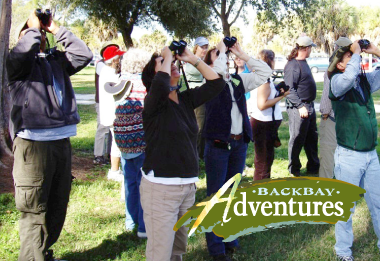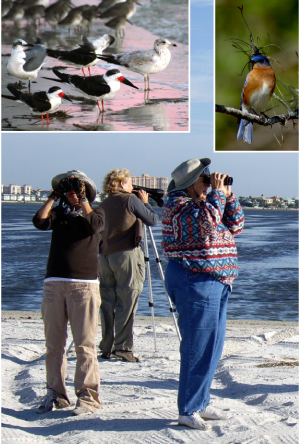 |
||||||||

Citizen-Scientists Discover New Traditions
By Ann Paul and Mark Rachal

Photo Carol Cassels
The Christmas Bird Count needs expert birders but less-experienced helpers are used to spot birds and then to count them.
As you finalize plans for a festive holiday season, consider adding a new tradition to your family’s annual rituals: Join your local Audubon Society for the 113th Christmas Bird Count (CBC). The world’s longest-running wildlife census, it actually grew out of an even older holiday tradition known as the Christmas Side Hunt. People would choose sides and go afield with their guns — whoever brought in the most feathered and furred quarry won.
Beginning on Christmas Day 1900, ornithologist Frank Chapman proposed a new holiday tradition that would count birds rather than kill them. That first year, 27 participants in locations across the country counted about 90 species. Last year, 60,000 people identified 646 species, counting 5.7 million birds in just the U.S. alone.
This Christmas, regional chapters of Audubon are coordinating events from Dec. 14 to Jan. 5, 2013 – the multiple dates allow birders to participate in more than one event.
There is a clear methodology to the CBC but it doesn’t require specific expertise to participate. “Count Compliers” identify teams to cover specific spots within a circle with a 15-mile diameter that stays the same from year to year. Each team includes at least one expert birder but spotters who look for birds in different directions and compilers who write down data as the experts count birds also are critical to the success of the CBC.

Photo credits: Melanie Higgins, John Miller and Carol Cassels.
Top left, black skimmers and gulls at sunset. Top right, a male bluebird at Flatwood Park. Below, a flock of watchers checks out the birds.
In addition, if your home is within the boundaries of a count circle, you can report birds that visit your feeder if you sign up with the Count Complier in advance.
On the “big day,” hundreds of local residents will brave winter weather armed with binoculars, bird guides and checklist, typically in place before dawn to catch the early birds. Often family teams survey the same location year after year, so they know which birds to look for. In other cases, experts can survey their location in advance to determine which birds are most likely to be seen when the time comes to count them.
Of course, there’s always a friendly competition among the teams to count unusual birds, then everyone meets afterward for a CBC supper to share their experiences. “The CBC day is a lot of fun for me personally,” says Dave Bowman, count compiler for both the Alafia and Tampa CBCs. “It’s just great to be outside, in the field, on a treasure hunt, looking for birds, with my friends.”
Dates hadn’t been finalized for individual chapters as Bay Soundings went to press in late September, but they’ll be posted at www.fosbirds.org by mid-November. Or, if your holiday season is already overflowing, Audubon offers opportunities year-round for citizen-scientists.
- Audubon EagleWatch uses trained volunteers to track many of the state’s 1,200 nesting pairs of bald eagles. The nesting season extends from October 1 through May 15, with individual pairs often returning to the same nesting territory year after year. Learn more at http://www.baysoundings.com/fall2011/Stories/national-treasure.asp or contact Matt Smith at Audubon’s Center for Birds of Prey, 407-644-0190, mcsmith@audubon.org or http://fl.audubon.org/audubon-eaglewatch
- Great Backyard Bird Count (GBBC) held February 15-18, 2013, is an annual event that engages bird watchers of all ages in counting birds to create real-time snapshots of where birds are across the U.S. and Canada. Each checklist submitted by citizen scientists helps researchers at the Cornell Lab of Ornithology and the National Audubon Society learn more about how birds are doing – and how to protect them and the environment we share. Last year, participants turned in more than 104,000 checklists online, creating the continent's largest instantaneous snapshot of bird populations ever recorded. Learn more at www.birdcount.org
- Just as the CBC counts wintering birds and the GBBC counts migratory birds, the Florida Breeding Bird Atlas (FBBA) documents birds that rely on our state’s habitats to raise their young. Volunteers work through the Florida Ornithological Society, the Florida Fish and Wildlife Conservation Commission, Audubon Florida and the U.S. Geological Service to survey separate 1038 sections over a five-year period. Data will be compared with the first BBA conducted 25 years ago, giving clear information about current bird species use of Florida and changes in recent years. Beginning birders can be partnered with experts. Learn more at www.fosbirds.org
- The North American Migration Count (NAMC), coordinated by the Cornell Laboratory of Ornithology, uses citizen-scientists to document the status of bird migration on one specific day. Contact your local Audubon chapter or visit http://www.birds.cornell.edu/allaboutbirds/conservation/involved/migration for more information.
- Project Colony Watch is a volunteer citizen scientist program of Audubon’s Florida Coastal Islands Sanctuaries to protect birds nesting in colonies. Several islands in Tampa Bay are designated as Important Bird Areas because they host significant numbers of threatened or endangered birds. If you know of a colony of nesting birds and would like to help protect it, our Audubon staff at the Florida Coastal Islands Sanctuaries at 813-623-6826, mrachal@audubon.org or apaul@audubon.org
- Jay Watch volunteers focus on assessing the population and habitat of Florida’s only endemic bird species, the Florida Scrub-Jay. Each summer, volunteers are paired with field biologists to survey scrub-jay populations and, on alternate years, they also monitor vegetation conditions. Hundreds of volunteers have documented more than 800 jays on multiple sites in as many as 14 counties. Learn more at http://www.nature.org/ourinitiatives/regions/northamerica/unitedstates/florida/volunteer/jay-watch-volunteer-to-monitor-florida-scrub-jays.xml or contact Marianne Korosy at mkorosy@audubon.org
- Bird Stewards help protect birds nesting on beaches and their young by educating people, answering questions and protecting their nests from disturbance. Stewards receive training from Audubon, then are stationed on beaches near nesting bird sites with spotting scopes and binoculars so nesting activity can be observed without causing a disturbance. They distribute literature and provide information on the nesting behaviors of the different species, how various disruptions impact nesting success, and ways to reduce disruptions. Learn more at http://www.baysoundings.com/summer2011/Stories/Stewards-Protect-Beach-Nesting-Birds.asp
Ann Paul is regional coordinator for Audubon Florida, Mark Rachal is sanctuary manager for the Florida Coastal Islands Sancturies.
